Museums and Filming Locations in the Bridgerton Series
Bridgerton premiered on Netflix in December 2019, breaking viewership records. The show set in Regency London was filmed at various locations...
Jimena Escoto 22 July 2024
In Starz’s new period drama, Becoming Elizabeth, the series follows the young Elizabeth Tudor and her rise to the British throne during the 16th century. While the story might have captivated viewers, there has been no mention of the tapestries hanging in the background of numerous scenes in episode one of Becoming Elizabeth.
Starz has certainly given us some of the best royal dramas: The White Queen, The White Princess, and the most recent, The Spanish Princess. All were based on art historian Philippa Gregory’s books. Their new series, Becoming Elizabeth, was written by British playwright Anya Reiss.
The eight-episode series examines Elizabeth I’s teenage years at the English court before securing her crown as Queen of England. The actress Alicia von Rittberg plays the role of Elizabeth I, Romola Garai plays her half-sister Mary Tudor, and Oliver Zetterström plays their half-brother, Edward.
Countless articles have been published since the series premiere on June 12th. However, none have discussed the Renaissance tapestries hanging in the background of scenes.
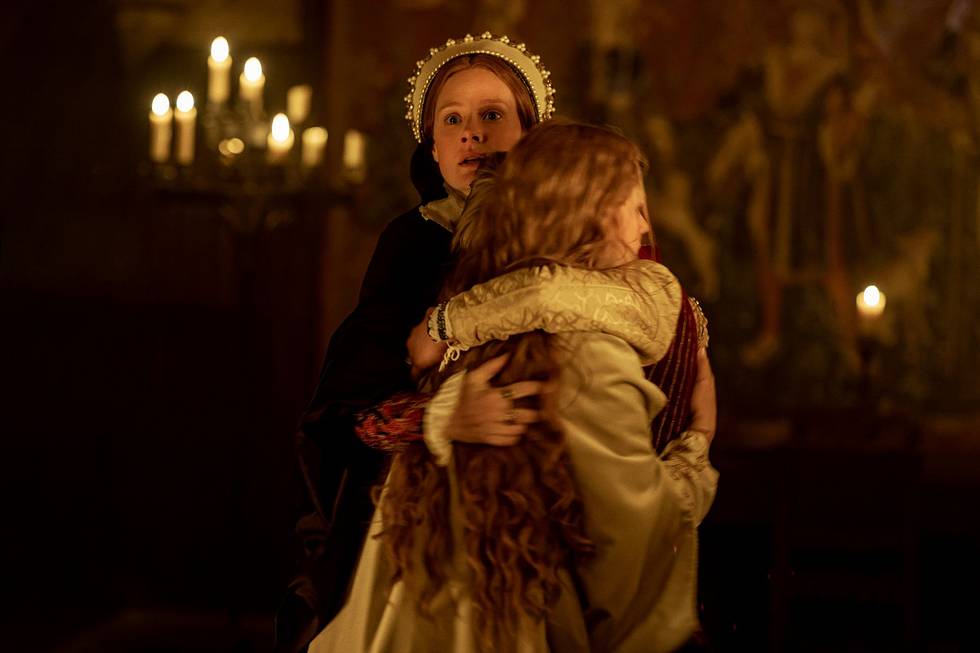
Still from Becoming Elizabeth, S1E01, Becoming Elizabeth/Starz. Vulture.
In the first episode, we are introduced to the main characters, Mary Tudor, Elizabeth Tudor, Edward VI (who becomes king), Catherine Parr, and Thomas Seymor. The 31-year-old Mary Tudor is the daughter of Henry VIII’s first wife, Catherine of Aragon. Henry famously divorced Catherine of Aragon to marry Anne Boleyn and form the Church of England. Thirteen-year-old Elizabeth Tudor is the daughter of Anne Boleyn, whose reputation was ruined after her beheading. Finally, young nine-year-old Edward was the son of Jane Seymor, Henry’s third wife.
Catherine Parr was the sixth wife of Henry VIII and became a mother figure to his three surviving children. Thomas Seymor is Edward’s uncle and was favored by Henry VIII because his sister, Jane, was the only wife to give him a son surviving past infancy.
The episode begins in January of 1547 with King Henry VIII pronounced dead, and all three of his children are rushed into a dark cellar in the middle of the night. Immediately, the camera focuses on the actors while a familiar millefleur tapestry hangs in the background.
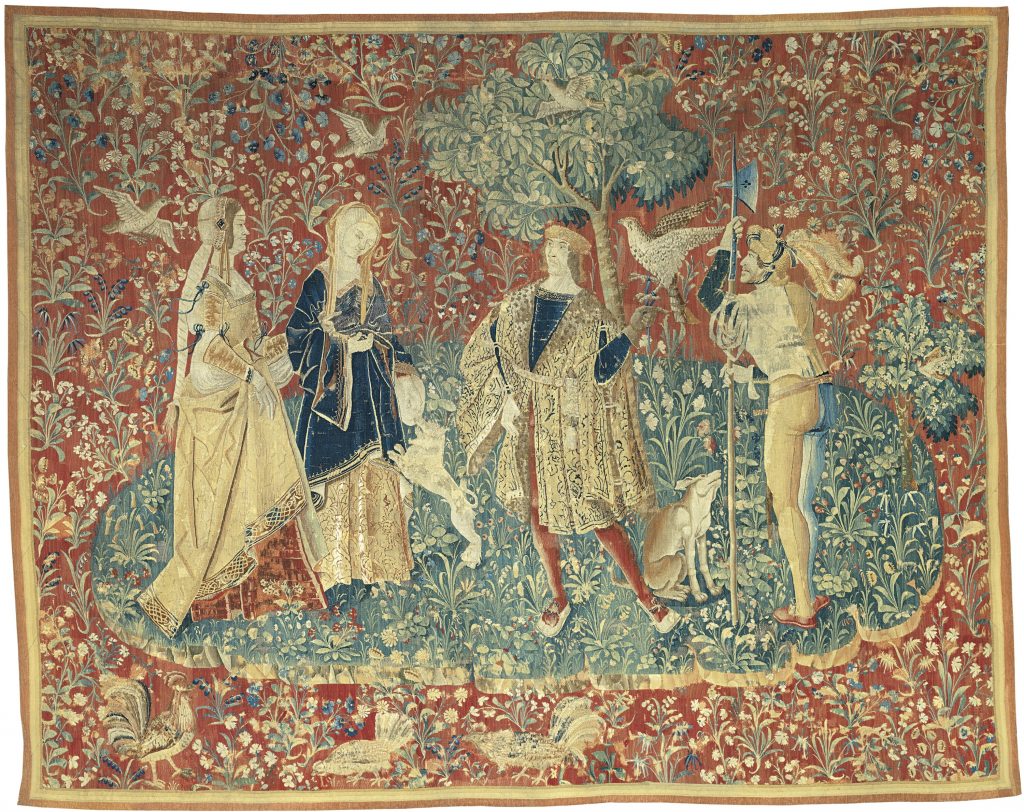
A Falconer with Two Ladies and a Foot Soldier, c. 1490-1510, wool and silk, slit and double interlocking tapestry weave, Bruges, Art Institute of Chicago, Chicago, IL, USA.
After speaking to the production graphic designer, Rosie Carmichael, she mentioned the tapestry in Becoming Elizabeth was possibly a reproduction. However, the original tapestry is called A Falconer with Two Ladies and a Foot Soldier. It was presumably made in Bruges, Belgium, between 1490 and 1510. The tapestry is currently held at the Art Institute of Chicago and bears many similarities to The Lady and the Unicorn Tapestry set.
There are two elegantly dressed women, a falconer, a foot soldier, and a dog standing on a green island surrounded by millefleurs. Not much is known about the original owner of the tapestry. Yet, its millefleur design would have been a popular addition to a royal patron’s tapestry collection, such as Henry VIII.
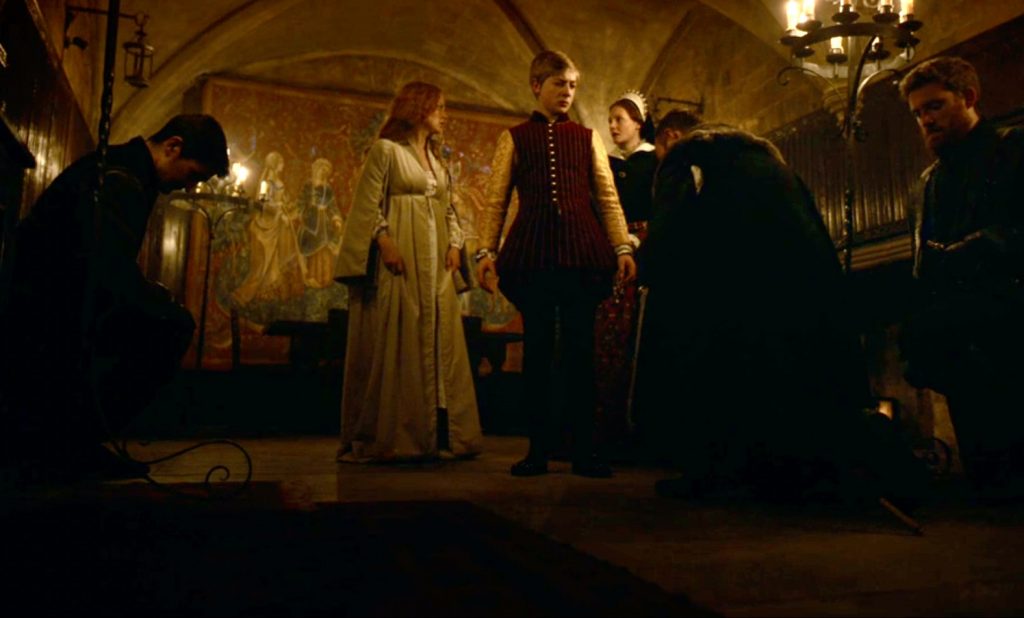
Art reference to A Falconer with Two Ladies and a Foot Soldier, S1E01. Becoming Elizabeth/Starz.
Although Henry VIII is famously known for having six wives and initiating the Protestant Reformation in England, he was also a tapestry collector. Henry VIII’s royal tapestry collection was nothing less than extraordinary. But out of the 300 tapestries recorded in Henry’s inventory, less than 30 remain today. Perhaps this is why the set decorators of the show Becoming Elizabeth decided to implement the tapestries at Berkeley Castle in Gloucestershire, England instead.
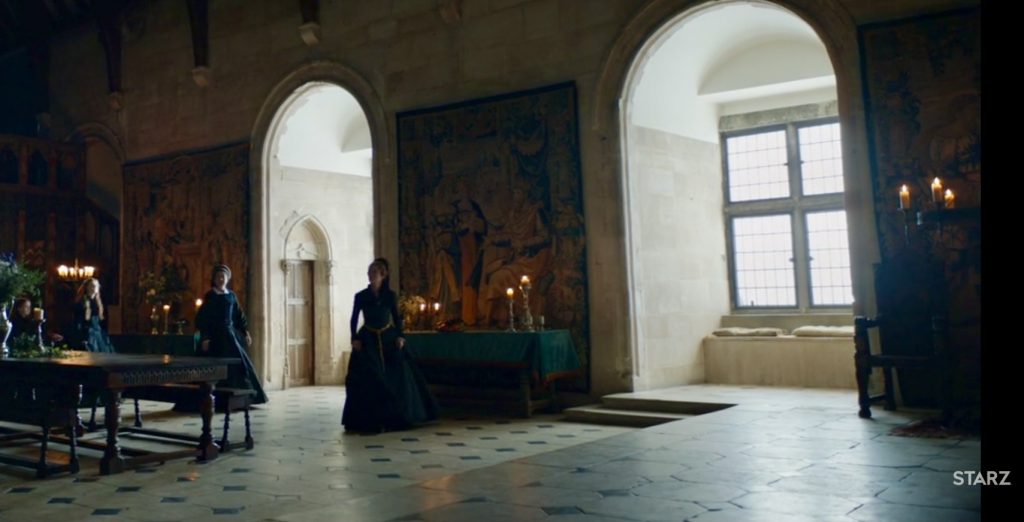
Art reference to three of the Oudenaarde Tapestries, S1E01. Becoming Elizabeth/Starz.
Only seven minutes later, in episode one, we watch Elizabeth I move in with her stepmother, Catherine Parr, at Chelsea Manor. Here, a new set of tapestries are depicted in the dining room as Catherine greets Elizabeth. In this scene, the three enormous tapestries cover the west wall, with the first pair flanking an arched stone window.
The scene took place at the 900-year-old Berkeley Castle, a filming location for season two of The Spanish Princess. According to the Friends of Berkeley Castle Newsletter from 2017, the Flemish tapestries were made in the late 16th century. They are attributed to the town of Oudenaarde and depict the story of Queen Esther, wife of King Ahasuerus (Xerxes) of Persia. Today they are known as the Oudenaarde tapestries, and all five hang in the Great Hall at Berkeley Castle.
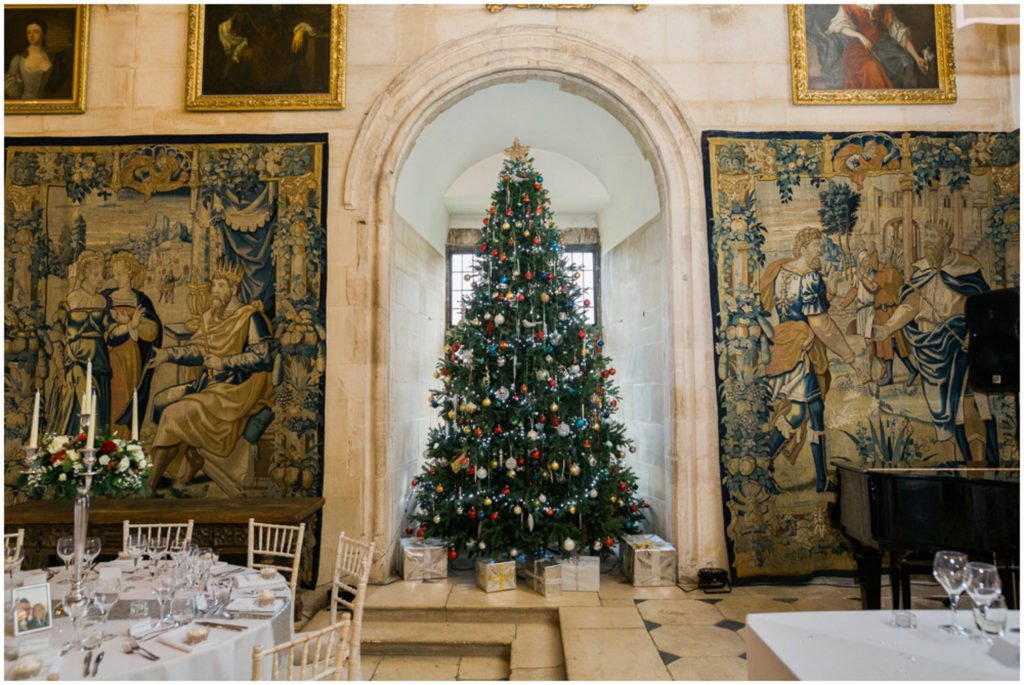
Two of the Oudenaarde Tapestries at Berkeley Castle, in Gloucestershire, UK. Christy Blanch Photography.
In a later scene of episode one, Catherine and Thomas converse in the dining room at night to discuss their new power at court. Behind them, the remaining two Oudenaarde tapestries are shown in candlelight for a few seconds. Due to their large size, the tapestries hang beside a fireplace on the north wall. These remarkable tapestries presented in Becoming Elizabeth are woven in shades of blue and yellow with intricate side borders. Featured on the borders are birds, fruit, urns, and foliage, wrapping around all five tapestries in the Great Hall at Berkeley Castle.
The Oudenaarde tapestries tell the story of how Esther became Queen of Persia. As the story goes, King Ahasuerus held a marvelous banquet for seven days. On the last day, he asked his wife Vashti to showcase her beauty by wearing nothing but her crown. After she refuses, the king casts her aside and chooses a new queen, Esther. Esther was a Jew who pleaded with the king to help save her people and change her destiny. Therefore, the five tapestries were commissioned as a tribute to God’s power and devotion.
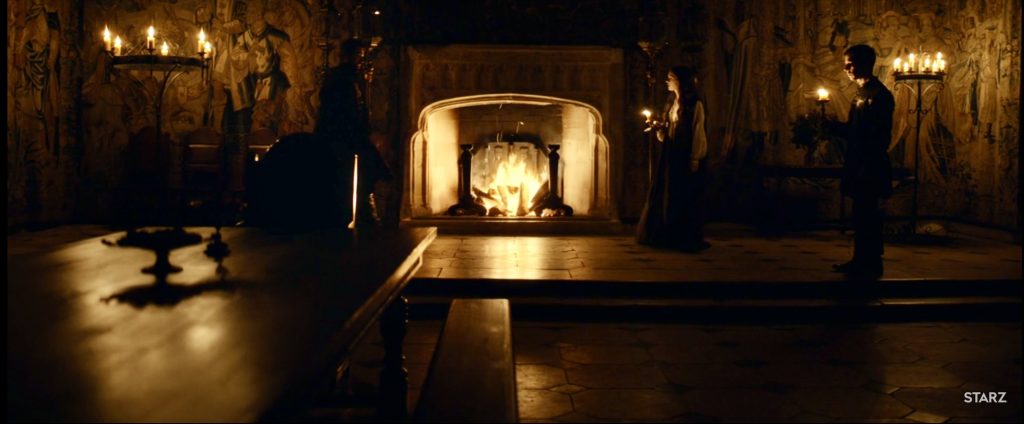
Art reference to two of the Oudenaarde Tapestries, S1E01. Becoming Elizabeth/Starz.
Since Berkeley Castle has been used as a filming location for many royal Tudor dramas, it is not surprising that Becoming Elizabeth would as well. The castle’s history is directly linked to Henry VIII, Anne Boleyn, and Elizabeth I. During the summer of 1535, while on progress, Henry VIII and Anne Boleyn visited Berkeley Castle. While it is not historically confirmed, presumably, they stayed there for a week. Sometime during the end of the 15th century, the castle might have been owned by the crown during Henry VII’s reign. Queen Elizabeth I also visited Berkeley Castle many times during her reign. One of the many treasures there today includes her bedspread.
So, next time you are in Gloucestershire, England, make sure to stop by Berkeley Castle and see the 16th-century Flemish tapestries featured in Becoming Elizabeth.
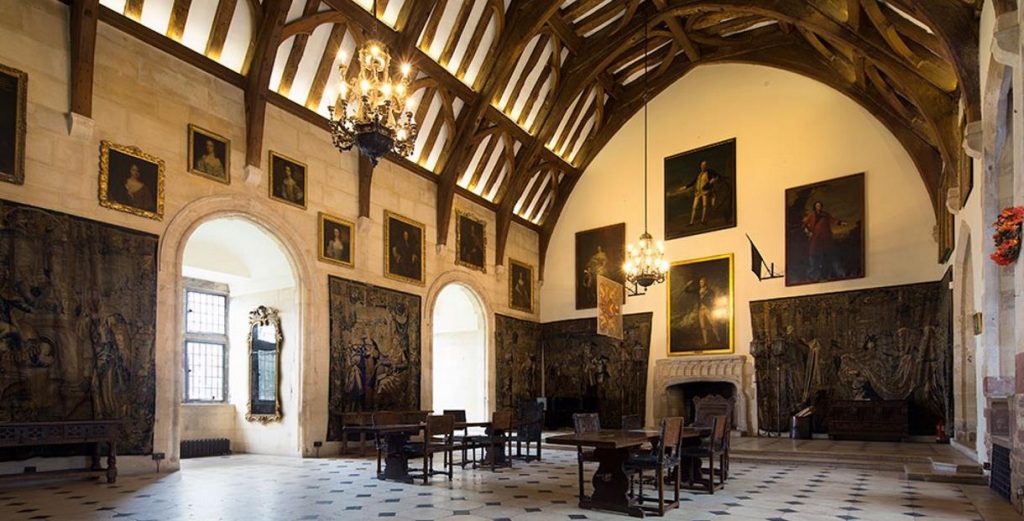
The five Oudenaarde Tapestries in the Great Hall at Berkeley Castle, in Gloucestershire, UK. Cotswold.
Thomas P. Campbell and Maryan Wynn Ainsworth. Tapestry in the Renaissance: Art and Magnificence. Metropolitan Museum of Art, 2002.
Elizabeth Balch. “Glimpses of Old English Homes. 1.” The English Illustrated Magazine 64 (1889): 285-297.
DailyArt Magazine needs your support. Every contribution, however big or small, is very valuable for our future. Thanks to it, we will be able to sustain and grow the Magazine. Thank you for your help!